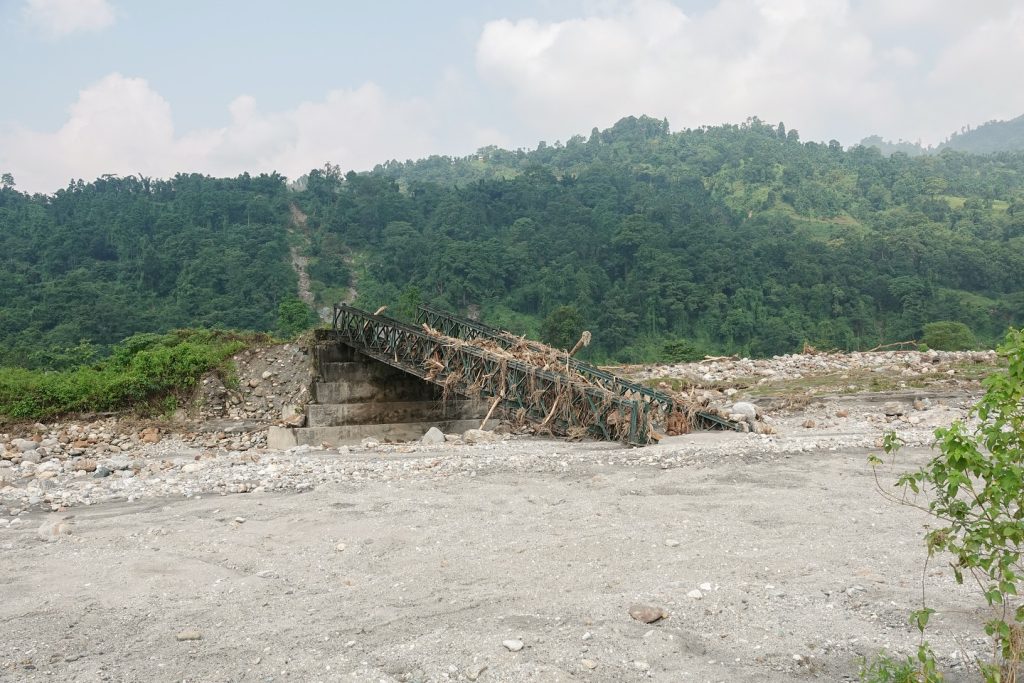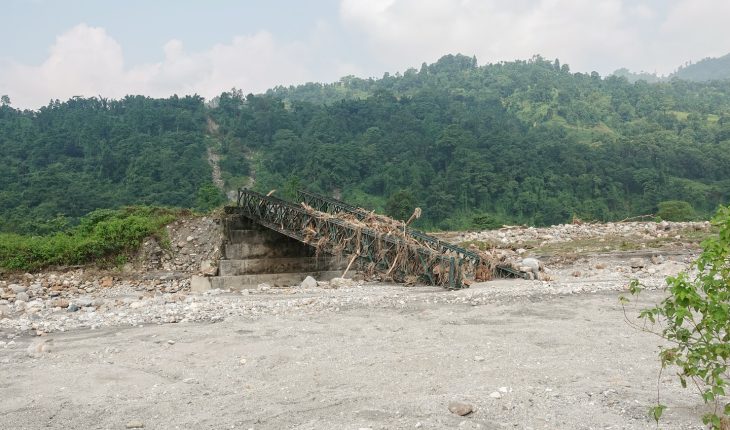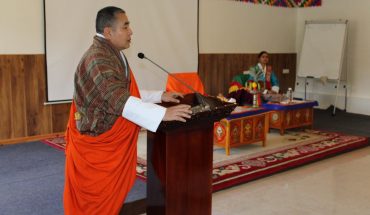
Torrential rains unleash widespread destruction across Samtse, Haa, and Chhukha; emergency teams battle to restore vital links as climate extremes intensify
KINZANG DORJI TSHERING | Thimphu
Bhutan has suffered extensive infrastructure damage following the recent heavy monsoon rains, with more than 30 bridges across several dzongkhags either washed away or severely damaged. The impacts have been most pronounced in Samtse, Haa, and Chhukha, where continuous rainfall and swollen rivers have caused widespread destruction, disrupted connectivity and isolated several rural communities.
According to reports compiled from local authorities and the Department of Surface Transport, at least 31 bridges, including bailey, suspension, culvert, and wooden bridges, were either washed away or rendered unusable by floods and swollen streams. The damage highlights the growing vulnerability of Bhutan’s infrastructure to extreme weather events intensified by climate change.
The Samtse dzongkhag has been among the most severely affected. Within the gewogs of Sangnagcholing, Denchukha, Dumtey, Norbugang, and Ugyentse, eight bridges were reported either washed away or damaged. In Sangnagcholing gewog alone, the Jitey Khola Bailey Bridge, Jiti Khola Culvert Bridge, and Jiti Khola Bailey Bridge (2) were all impacted—the first two completely washed away while the third sustained major structural damage. Further downstream in Denchukha, the Denchukha Bailey Bridge and the Damji-Denchukha suspension bridge were also swept away by strong currents. The situation is no better in Dumtey gewog, where the Namchu Bailey Bridge collapsed under the force of floodwaters, cutting off access to several remote villages.
In Norbugang gewog, the Ngangladrang Suspension Bridge was washed away, while in Ugyentse, the Kuchi-Diana Bailey Bridge was left partially damaged, leaving residents dependent on temporary makeshift crossings. Local residents in these gewogs have reported severe transportation disruptions, as many of these bridges serve as vital lifelines connecting farms, schools, and health centers. Authorities have been mobilized to assess the full extent of the damage and provide temporary relief routes.
In Haa, the dzongkhag witnessed widespread destruction, particularly in Gakiling gewog, where multiple bridges—both public and privately constructed—have been destroyed. These include the Somchu Wooden Bridge, Amochu Bailey Bridge, Somchu Bailey Bridge, Pungthrachu Bailey Bridge (private), Titim Bailey Bridge, Sherchu Bailey Bridge, Babuna Culvert Bridge, and the Somchu Suspension Bridge near Thangdokha, all of which were reported washed away. Adding to the devastation, the Sertena Suspension Bridge in Gakiling and the Lamjeygang wooden bridge in Samar gewog were also swept away by flash floods, leaving several communities disconnected. Residents have voiced growing concerns over the repeated damage to infrastructure in these flood-prone areas. Many noted that the region’s steep terrain and increasing rainfall intensity have made such disasters more frequent in recent years.
In Chhukha dzongkhag, multiple gewogs reported extensive losses. The Bongo gewog saw the Getanachu Bailey Bridge washed away and the Toktogom bailey bridge damaged. Meanwhile, in Phuntsholing, the Pachu-Lingdhen bailey bridge was swept away, while the Nyechu bailey bridge sustained significant damage. The Darla gewog’s Jigmechu-Pipping suspension bridge was also damaged, and in Getena, the Chiyuel-Pangserla bailey bridge was completely washed away. Likewise, Logchina gewog reported the loss of the Hatigar bailey bridge, while Metakha gewog confirmed the destruction of the Menlungpa Bailey Bridge. The widespread damage has prompted emergency responses from the dzongkhag administration, which has begun deploying engineers and local task forces to assess the affected areas. However, accessibility remains a major challenge as several routes remain cut off.
Central Bhutan has not been spared either. In Wangduephodrang, a wooden bridge in Ekerwog under Gangtey gewog sustained major damage, and the Ula bailey bridge in Rubisa gewog was washed away. These damages have impacted local commuters and farmers who rely on these bridges for transporting goods and farm produce. In Bumthang, the Menchugang suspension bridge in Chokhor gewog was damaged, while the Jakar crematorium culvert bridge was washed away, affecting access routes within the region.
Amid the devastation, eyewitnesses shared their experiences of witnessing the bridges collapse and the challenges that followed.
Tenzin, a farmer from Sangnagcholing, Samtse, was among the first to witness the destruction of the Jitey Khola bailey bridge.
He recalled, “It happened very suddenly. The river was swelling fast after continuous rainfall. By late afternoon, the water had risen so high that it started hitting the bridge deck. Within minutes, the bridge gave way and was swept downstream. People were shouting and watching helplessly from the bank.”
When asked how the loss has affected daily life, Tenzin said, “This bridge connected our village to the main road. Now we have to walk several extra hours to reach the nearest crossing. Schoolchildren, farmers, and even those needing hospital care are struggling. We feel completely cut off.”
He added that there were no casualties, saying, “Luckily, no vehicles were crossing at that time. A few people were nearby trying to see the water level, but they moved away just in time. If it had happened at night, there could have been casualties.”
Sangay Choden, a shopkeeper from Gakiling, Haa, witnessed multiple bridges being washed away in her gewog. “We see heavy rain every year, but this time was much worse,” she said. “The rivers were so strong that even the concrete supports couldn’t hold. It was the first time I’ve seen so many bridges collapse one after another in a single night.”
Speaking on the response from local authorities, Sangay Choden explained, “The gewog officials visited and took pictures of the damage. They’ve told us to stay away from the rivers and said that emergency materials will be brought in once the weather improves. But so far, we haven’t seen any proper road connection restored.”
She added that transportation and supplies remain a serious concern. “We’re carrying goods and supplies on our backs across temporary wooden planks. Some people have to wade through the river early in the morning when the water is lower. It’s risky, but we have no other choice. Many of our shops are running out of essentials because vehicles can’t reach us.”
Tashi, a villager from Rubisa, Wangduephodrang, also witnessed a bridge near his area being swept away. He stressed the need for stronger infrastructure, saying, “I think stronger bridges need to be built, not just temporary bailey ones. They should be made to withstand heavy rainfall and floods. Also, we need proper drainage channels and early warnings when the water levels rise.”
When asked about preparedness, Tashi said, “Not really. We heard general weather warnings, but nothing specific about our area. If there were clearer alerts, people could have moved livestock and goods to safer ground earlier. The floods came too suddenly for us to react.”
Officials from the Department of Surface Transport and local administrations are currently conducting assessments to estimate the cost of reconstruction and prioritize critical routes. Emergency measures such as temporary foot crossings and portable bridges are being considered in areas where access is vital.
A senior official from the Ministry of Infrastructure and Transport emphasized that the government is expediting damage assessments and mobilizing resources to restore connectivity. However, rebuilding efforts could take time due to ongoing rainfall and unstable river conditions.
The recent wave of destruction serves as a stark reminder of Bhutan’s growing exposure to climate-induced disasters. With climate change intensifying monsoon patterns, the infrastructure resilience and improved drainage systems are becoming increasingly crucial. For now, communities across Samtse, Haa, and Chhukha await urgent interventions as the country works to repair vital connections and prevent further loss.





